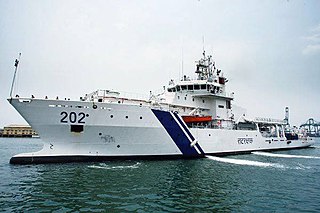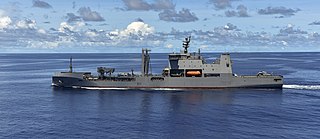
NoCGV Svalbard (W303) is a Norwegian Coast Guard icebreaker and offshore patrol vessel constructed by Langsten at Tangen Verft shipyard in Kragerø and launched on 17 February 2001. She was named 15 December 2001 in Tomrefjord with Minister of Defence Kristin Krohn Devold as godmother, and delivered to the Coast Guard on 18 January 2002. She entered service in mid-2002 and is homeported in Sortland. Her primary operating area is in the Arctic waters north of Norway, the Barents Sea and around the Svalbard islands.

The Royal Norwegian Navy is the branch of the Norwegian Armed Forces responsible for naval operations of Norway. As of 2008, the Royal Norwegian Navy consists of approximately 3,700 personnel and 70 vessels, including 4 heavy frigates, 6 submarines, 14 patrol boats, 4 minesweepers, 4 minehunters, 1 mine detection vessel, 4 support vessels and 2 training vessels. It also includes the Coast Guard.

A patrol boat is a relatively small naval vessel generally designed for coastal defence, border security, or law enforcement. There are many designs for patrol boats, and they generally range in size. They may be operated by a nation's navy, coast guard, police, or customs, and may be intended for marine, estuarine, or river environments.

The Fridtjof Nansen-class frigates are a class of frigates that are the main surface combatant units of the Royal Norwegian Navy. The ships are named after famous Norwegian explorers, with the lead ship of the class bearing the name of Fridtjof Nansen, the Norwegian scientist, explorer and humanitarian. Five ships were ordered from Spanish shipbuilder Bazan.

The Coast Guard Administration of the Ocean Affairs Council, also known as the Taiwan Coast Guard or R.O.C. Coast Guard, is charged with maintaining law and order, protecting the resources of the territorial waters of the Republic of China (Taiwan), which surrounds Taiwan, Penghu, Kinmen, Matsu Islands, Green Island, Orchid Island, Pratas Island (Tungsha/Dongsha), and Nansha Islands as well as providing a first line of defense along coastal areas against smugglers and illegal immigrants. The CGA is considered a civilian law enforcement agency under the administration of the Ocean Affairs Council of the Executive Yuan, though during emergencies it may be incorporated as part of the Republic of China Armed Forces.

The Nordkapp class is a Norwegian Coast Guard ship class built in the 1980s, and is used for rescue, fishery inspection, research purposes and general EEZ patrol in Norwegian waters. It is a class of ships purpose-built for the Norwegian Coast Guard with a secondary role as wartime naval escorts. The Norwegian Coast Guard is a part of the Royal Norwegian Navy, and has some police authority.

The Norwegian Coast Guard is a maritime military force which is part of the Royal Norwegian Navy. The coast guard's responsibility are for fisheries inspection, customs enforcement, border control, law enforcement, shipping inspection, environmental protection, and search and rescue. It operates throughout Norway's 2,385,178-square-kilometer (920,922 sq mi) exclusive economic zone (EEZ), internal waters and territorial waters. It is headquartered at Sortland Naval Base. In 2013 the Coast Guard had 370 employees, including conscripts, and a budget of 1.0 billion Norwegian krone.

NoCGV Barentshav is a large offshore patrol vessel of the Norwegian Coast Guard, and is their first liquefied natural gas-powered vessel. The contract was signed 21 October 2005, and NoCGV Barentshav was delivered in August 2009.

The Maldivian Coast Guard is the naval or maritime arm of the Maldives National Defence Force (MNDF). Because the Maldives does not have a navy, the MNDF Coast Guard functions as the armed maritime force of the nation with a charter to contribute to national defence and by and large to respond to issues related to the maritime security of the nation. Therefore, the Coast Guard is documented as the custodian of the Maldives Maritime Domain. Maritime security is a constituent ingredient of the national security in a maritime nation such as the Maldives and its significance is best understood when one perceives the island or the archipelagic nature of the country.

The Barentshav class of offshore patrol vessels consists of three vessels powered by liquefied natural gas. Ordered for the Norwegian Coast Guard, their main tasks are EEZ patrol, fishery inspection, search and rescue as well as tug readiness along the shore of Norway which is seeing increasing traffic from tankers.

ICGV Þór (Thor) is an UT 512L type offshore patrol vessel designed by Rolls-Royce for the Icelandic Coast Guard, built to replace the aging ICGV Óðinn. The construction of the ship was approved by the Icelandic government on 4 March 2005. Construction of the ship began at the ASMAR Naval Shipyard in Talcahuano, Chile, on 16 October 2007. Construction was delayed by over a year due to the 2010 Chilean earthquake, but damage to the structure of the ship was not as detrimental as had been expected. After repairs, the ICGV Þór was delivered to ICG personnel on 23 September 2011 in Chile. She arrived in Reykjavík on 27 October 2011. Its main tasks are EEZ patrol, fishery inspection and search and rescue support. The ship is named after the Norse god Thor.

The United Arab Emirates Navy is the naval branch of the United Arab Emirates Armed Forces. It is small force of about 3,000 personnel. It maintains 12 well-equipped coastal patrol boats and eight missile boats. Although primarily concerned with coastal defense, the Navy is constructing a six-unit class of blue water corvettes in conjunction with French shipbuilder CMN. The UAE maintains a small battalion-sized marine force called the UAE Marines equipped with BMP-3 armoured personnel carriers.

An emergency tow vessel, also called emergency towing vessel, (ETV) is a multi purpose boat used by state authorities to tow disabled vessels on high seas in order to prevent dangers to man and environment. The disabled vessel is either towed to a safe haven or kept in place against wind and current until commercial assistance by tug boats has arrived on site or until it has been repaired to the extent of being able to manoeuvre on its own. The need for ETVs as a preventive measure has arisen since the number of available commercial salvage tugs was reduced while potential dangers from individual vessels have increased. E.g. Spain has fourteen, Turkey has eleven, Germany operates eight, Norway has seven, France has five, Sweden three and the Netherlands, Poland, South Africa, Iceland and Finland each have one official emergency tug boat. Australia also operates emergency response vessels. The United Kingdom's four strong ETV fleet was to be disbanded in September 2011 due to budget cuts but the two vessels operating in Scottish waters received an extension of contract until the end of 2011.

The Samudra-class Pollution Control Vessel is a class of three vessels built by the ABG Shipyard in Gujarat for Indian Coast Guard.
Vardø Vessel Traffic Service Centre, also known as Norwegian Oceanic Region Vessel Traffic Service, is a vessel traffic service situated in the town of Vardø in Vardø, Norway. It is responsible for monitoring ship traffic off the baseline of Norway throughout the exclusive economic zone (EEZ), including the areas around Jan Mayen and Svalbard. It has special responsibilities for the sealanes into Hammerfest and Sveagruva.

RV Kronprins Haakon is a Norwegian icebreaking polar research vessel owned by the Norwegian Polar Institute. The shiptime use is divided between the main users, the University of Tromsø, Norwegian Polar Institute and Norwegian Institute of Marine Research. She was built at Fincantieri shipyard in Genova, Italy, and delivered in 2018.

HMNZS Aotearoa, formerly the Maritime Sustainment Capability project, is an auxiliary ship of the Royal New Zealand Navy. Builder Hyundai Heavy Industries delivered the ship to the Navy in June 2020, and she was commissioned into service on 29 July 2020. Full operational capability was expected to be achieved in 2021. The vessel will serve as a replenishment oiler, and has replaced HMNZS Endeavour, the Navy’s last fleet oiler, which was decommissioned in December 2017.
M/S Stålbas, formerly the Norwegian Coast Guard cutter Stålbas offshore patrol vessel, is a multifunction cargo vessel. It was converted to be able to perform crab fishing in 2021, and featured on the Discovery Channel USA show Deadliest Catch on Discovery+ and Discovery Channel Canada in the 2022 TV show season; and Deadliest Catch: The Viking Returns on Discovery USA for the 2022 fall TV season.

RFA Stirling Castle is a ship of the Royal Fleet Auxiliary operated by the Ministry of Defence. Acquired in 2023, the ship entered drydock at HMNB Devonport for modification into a trials platform for autonomous minehunting systems that are to operate from a larger mother ship. The ship was formerly named MV Island Crown, and used as an offshore supply vessel operated by Island Offshore. The vessel was sold to the Ministry of Defence in January 2023 for £40 million.

















